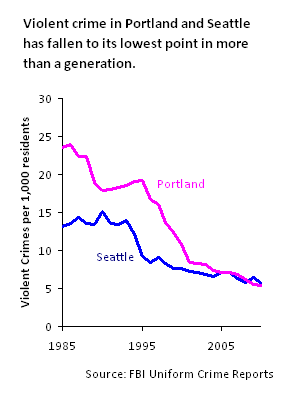
How’s life in your urban hellhole?
I kid, of course. People often think of big cities as hotbeds of crime—an impression that the “if it bleeds, it leads” nightly newscasts help to foster. But the reality is very different. Today, the Northwest’s big cities are safer than they’ve been in decades.
Preliminary 2010 statistics from the FBI’s Uniform Crime Reports suggest that Northwest crime rates are continuing the declines that began decades ago. And over time, the biggest cities have seen particularly sharp drops. Today, Portland and Seattle have slightly lower violent crime rates than some smaller Northwest cities, such as Spokane. And among the nation’s largest cities (those with more than 500,000 residents) Portland and Seattle rank 8th and 10th, respectively, for the lowest reported rates of violent crime.
Of course, regional drops in crime are all part of a larger national trend: crime rates have been falling dramatically in the US since the early 1990s. Much of that shift is simple demographics. As the Baby Boom generation moved out of the crime-prone teens and 20s, crime rates fell. Smaller numbers of young men explain a surprising share of the drop in crime.
But in spite of all this good news, when you ask people about their opinions on crime trends, you hear a different story. According to the University of Albany’s Sourcebook on Crime Statistics, year after year after year, most people say that crime is getting worse. In fact, during the period of the steepest declines, the public got the general direction of crime trends right only once: in 2001, when 41 percent said that crime was increasing, and 43 percent said it was decreasing. What this shows me is that if you want the true crime story, you’ve got to stick to the facts—opinions and hearsay will get you nowhere.

Comments are closed.